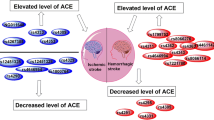Abstract
Hypertension is one of the co-morbid conditions for stroke and profoundly increases its incidence. Angiotensin II (AngII) is shown to be at the center stage in driving the renin angiotensin system via activation of angiotensin 1 receptor (AT1R). This makes the AT1R gene one of the candidates whose differential regulation leads to the predisposition to disorders associated with hypertension. A haplotype block of four SNPs is represented primarily by haplotype-I, or Hap-I (TTAA), and haplotype-II, or Hap-II (AGCG), in the promoter of human AT1R (hAT1R) gene. To better understand the physiological role of these haplotypes, transgenic (TG) mice containing Hap-I and Hap-II of the hAT1R gene in a 166-kb bacterial artificial chromosome (BAC) were generated. Mice received injection of endothelin-1 (1 mg/ml) directly in to the striatum and were evaluated for neurologic deficit scores and sacrificed for analysis of infarct volume and mRNA levels of various proteins. Mice containing Hap-I suffered from significantly higher neurological deficits and larger brain infarcts than Hap II. Similarly, the molecular analysis of oxidant and inflammatory markers in brains of mice showed a significant increase (p < 0.05) in NOX-1 (2.3-fold), CRP (4.3-fold), and IL6 (1.9-fold) and a corresponding reduced expression of antioxidants SOD (60 %) and HO1 (55 %) in Hap-I mice as compared to Hap-II mice. These results suggest that increased expression of hAT1R rendered Hap-I TG mice susceptible to stroke-related pathology, possibly due to increased level of brain inflammatory and oxidative stress markers and a suppressed antioxidant defense system.





Similar content being viewed by others
References
Dubow J, Fink ME (2011) Impact of hypertension on stroke. Curr Atheroscler Rep 13(4):298–305. doi:10.1007/s11883-011-0187-y
Go AS, Mozaffarian D, Roger VL, Benjamin EJ, Berry JD, Blaha MJ, Dai S, Ford ES et al (2014) Heart disease and stroke statistics—2014 update: a report from the American Heart Association. Circulation 129(3):e28–e292. doi:10.1161/01.cir.0000441139.02102.80
Unger T, Badoer E, Ganten D, Lang RE, Rettig R (1988) Brain angiotensin: pathways and pharmacology. Circulation 77(6 Pt 2):I40–54
Li J, Culman J, Hortnagl H, Zhao Y, Gerova N, Timm M, Blume A, Zimmermann M et al (2005) Angiotensin AT2 receptor protects against cerebral ischemia-induced neuronal injury. FASEB J 19(6):617–619. doi:10.1096/fj.04-2960fje
Ganten D, Boucher R, Genest J (1971) Renin activity in brain tissue of puppies and adult dogs. Brain Res 33(2):557–559
Ganten D, Marquez-Julio A, Granger P, Hayduk K, Karsunky KP, Boucher R, Genest J (1971) Renin in dog brain. Am J Physiol 221(6):1733–1737
Wright JW, Harding JW (2013) The brain renin-angiotensin system: a diversity of functions and implications for CNS diseases. Archiv Eur J Physiol 465(1):133–151. doi:10.1007/s00424-012-1102-2
Ando H, Zhou J, Macova M, Imboden H, Saavedra JM (2004) Angiotensin II AT1 receptor blockade reverses pathological hypertrophy and inflammation in brain microvessels of spontaneously hypertensive rats. Stroke 35(7):1726–1731. doi:10.1161/01.STR.0000129788.26346.18
Faraci FM, Heistad DD (1990) Regulation of large cerebral arteries and cerebral microvascular pressure. Circ Res 66(1):8–17
Saavedra JM, Nishimura Y (1999) Angiotensin and cerebral blood flow. Cell Mol Neurobiol 19(5):553–573
Edvinsson L, Hardebo JE, Owman C (1979) Effects of angiotensin II on cerebral blood vessels. Acta Physiol Scand 105(3):381–383. doi:10.1111/j.1748-1716.1979.tb06355.x
Warnholtz A, Nickenig G, Schulz E, Macharzina R, Brasen JH, Skatchkov M, Heitzer T, Stasch JP et al (1999) Increased NADH-oxidase-mediated superoxide production in the early stages of atherosclerosis: evidence for involvement of the renin-angiotensin system. Circulation 99(15):2027–2033
Yang D, Elner SG, Bian ZM, Till GO, Petty HR, Elner VM (2007) Pro-inflammatory cytokines increase reactive oxygen species through mitochondria and NADPH oxidase in cultured RPE cells. Exp Eye Res 85(4):462–472. doi:10.1016/j.exer.2007.06.013
Ito T, Yamakawa H, Bregonzio C, Terron JA, Falcon-Neri A, Saavedra JM (2002) Protection against ischemia and improvement of cerebral blood flow in genetically hypertensive rats by chronic pretreatment with an angiotensin II AT1 antagonist. Stroke 33(9):2297–2303
Nishimura Y, Ito T, Saavedra JM (2000) Angiotensin II AT(1) blockade normalizes cerebrovascular autoregulation and reduces cerebral ischemia in spontaneously hypertensive rats. Stroke 31(10):2478–2486
Ito T, Nishimura Y, Saavedra J (2001) Pre-treatment with candesartan protects from cerebral ischaemia. J Renin-Angiotensin-Aldosterone Syst 2(3):174–179. doi:10.3317/jraas.2001.024
Jain S, Prater A, Pandey V, Rana A, Puri N, Kumar A (2013) A haplotype of Angiotensin receptor type 1 associated with human hypertension increases blood pressure in transgenic mice. J Biol Chem 288(52):37048–37056. doi:10.1074/jbc.M113.520023
Benigni A, Corna D, Zoja C, Sonzogni A, Latini R, Salio M, Conti S, Rottoli D et al (2009) Disruption of the Ang II type 1 receptor promotes longevity in mice. J Clin Invest 119(3):524–530. doi:10.1172/JCI36703
D’Haene B, Vandesompele J, Hellemans J (2010) Accurate and objective copy number profiling using real-time quantitative PCR. Methods 50(4):262–270. doi:10.1016/j.ymeth.2009.12.007
Soylu H, Zhang D, Buist R, Martin M, Albensi BC, Parkinson FE (2012) Intracortical injection of endothelin-1 induces cortical infarcts in mice: effect of neuronal expression of an adenosine transporter. Exp Transl Stroke Med 4(1):4. doi:10.1186/2040-7378-4-4
Shah ZA, Nada SE, Dore S (2011) Heme oxygenase 1, beneficial role in permanent ischemic stroke and in Gingko biloba (EGb 761) neuroprotection. Neuroscience 180:248–255. doi:10.1016/j.neuroscience.2011.02.031
Livak KJ, Schmittgen TD (2001) Analysis of relative gene expression data using real-time quantitative PCR and the 2(-Delta Delta C(T)) Method. Methods 25(4):402–408. doi:10.1006/meth.2001.1262
Bohm F, Pernow J (2007) The importance of endothelin-1 for vascular dysfunction in cardiovascular disease. Cardiovasc Res 76(1):8–18. doi:10.1016/j.cardiores.2007.06.004
Kim JA, Berliner JA, Nadler JL (1996) Angiotensin II increases monocyte binding to endothelial cells. Biochem Biophys Res Commun 226(3):862–868. doi:10.1006/bbrc.1996.1441
Petnehazy T, Stokes KY, Wood KC, Russell J, Granger DN (2006) Role of blood cell-associated AT1 receptors in the microvascular responses to hypercholesterolemia. Arterioscler Thromb Vasc Biol 26(2):313–318. doi:10.1161/01.ATV.0000193625.32499.71
Sources of Funding
This study was funded in part by the Research Support: NIH grants HL081752 and HL66296 to AK and NIH grant R00AT004197 to ZAS.
Author information
Authors and Affiliations
Corresponding authors
Rights and permissions
About this article
Cite this article
Jain, S., Tulsulkar, J., Rana, A. et al. Transgenic Mice Overexpressing Human Angiotensin I Receptor Gene Are Susceptible to Stroke Injury. Mol Neurobiol 53, 1533–1539 (2016). https://doi.org/10.1007/s12035-015-9109-2
Received:
Accepted:
Published:
Issue Date:
DOI: https://doi.org/10.1007/s12035-015-9109-2




